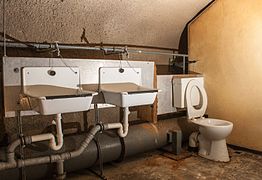Tucherkeller (Nuremberg)
The Tucherkeller is a former beer cellar and abandoned underground bunker in the northern part of the old town of Sebald in the old town of Nuremberg .
location
The former rock cellar is located between Maxtormauer , Treibberg and north of Hirschelgasse.
description
The cellar is named after the Tucher Bräu . The Tucherkeller is divided into the small and the large Tucherkeller. Both cellars originally served as a beer cellar for the Tucherbrauerei, which once had its brewery here . Today there is a building of the economics and social science faculty (WiSo) of the Friedrich-Alexander-Universität on the former brewery area . Only a part of the formerly spacious and multi-storey cellar is still preserved.
People have been driving tunnels and cellars in the Nuremberg rocks since the 14th century . The original rock cellars of the Tucherkeller were probably driven into the sandstone cliffs of the Nuremberg castle hill in the 18th and 19th centuries . The two cellars are connected by a tunnel. During the Second World War , the cellars were expanded and served the Nuremberg population as an air raid shelter .
With the construction of the WiSo, which began in 1972, the basement was cut when the excavation pit was excavated. Parts of the former facility then had to give way to the underground car park and the basement of the WiSo or were completely filled in for structural reasons. Today there is only one underground floor of the former multi-storey facility.
During the Cold War , part of the facility was expanded after the basic protection (14 days). For this purpose, secure entrances were created and the sandstone and brick walls were lined with shotcrete ( gate crested ). However, this expansion technique leads to lasting problems. Water from the sandstone can no longer freely escape, drain off and collect between the original wall and the gate retainer. The cladding is blasted off and the underlying structure is eroded . The technology of the bunker was elaborately designed. An automatic and hand-operated ventilation system, water supply, emergency kitchens, toilets, sand filters and emergency power generators were installed in the basement. Air protection doors were installed in such a way that the cellars could be divided into separate bunkers. The small Tucherkeller was designed for 590 people and the large Tucherkeller for 1290 people. The bunker has not been maintained since the end of the Cold War and has been left to decay.
Tucher studs
The bunker system is connected to other cellars such as the panier bunker and the Laufertor cellar . The connections between the cellars were created from 1943. In July 1943 there were huge fires and firestorms in Hamburg after devastating bombing raids . Then they began to dig the connecting tunnels. The aim was to evacuate people from affected areas underground while large fires were burning above. Plans from this time to connect all the cellars under the northern old town failed due to the unclear responsibilities between the building construction and civil engineering department, geology and the lack of workers and building materials.
Existing tunnels were used and expanded for the connections created. The Tucher tunnel, which runs about 8 to 12 meters below the Maxtorgraben, represents a connection. The tunnel, which is sometimes only 60 centimeters wide and up to 3 meters high, was expanded up to 2 meters. The Tucher tunnel runs west to the Paniersbunker, east to the Laufertor bunker and then merges into the Henninger drainage tunnel. The corridor east of the Tucherkeller can no longer be entered today and is closed with a grille.
The Tucher tunnel is also called the Tucher Canal . It was created in 1867 by the Tucherbrauerei. Water in the cellars endangered the quality and the yield of the beer and it served as a water collector and drainage channel. During the Second World War it was part of an escape route in the event of major fires and led underground to Wöhrder Wiese .
Access
The Tucherkeller are no longer open to the public. To commemorate the air raid on Nuremberg on January 2, 1945, the Nürnberger Felsengänge eV association offered special tours.
Picture gallery
Individual evidence
- ↑ Location of the Tucherkeller in the BayernAtlas , accessed on December 20, 2016
- ^ Geology of the Nuremberg Castle Hill , accessed on December 20, 2016
- ↑ History of FAU , accessed on December 20, 2016
- ↑ Research Group day eV, Tuchekeller , accessed on 20 December 2016
- ↑ Construction tools, Laufertorbunker , accessed on December 20, 2016
- ↑ Excursion to the unknown underworld Förderverein Nürnberger Felsengänge eV, accessed on December 20, 2016
- ↑ Special tours from 2.-8. January 2017, Förderverein Nürnberger Felsengänge eV accessed on December 20, 2016
literature
- Walter Herppich: The underground Nuremberg. Nuremberg 2001, ISBN 3-87191-301-4 .
Web links
Coordinates: 49 ° 27 ′ 29 ″ N , 11 ° 5 ′ 5 ″ E










